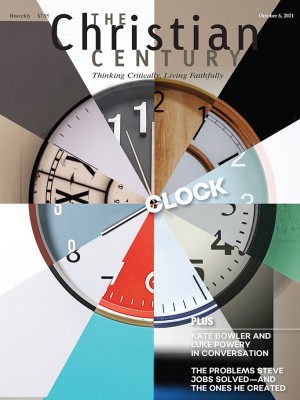Twenty years later, ‘In Christ Alone’ still inspires millions to sing

The melody that changed Keith Getty’s life was first scratched out on the back of an electric bill in a humble flat in Northern Ireland.
This isn’t great, he thought at the time.
But it was the best he could come up with. So he sent a recording of the melody on a CD to Stuart Townend, an English songwriter he’d met a few months earlier at a church conference, in hopes Townend might be able to turn the melody into a serviceable hymn.
That melody became the basis for “In Christ Alone,” which was released in 2001 and has become one of the most popular songs in Protestant churches, according to Christian Copyright Licensing International, which tracks songs sung in churches. The song also helped launch a new era of modern hymn writing.
Read our latest issue or browse back issues.
All of which came as a surprise to the song’s authors.
In a 2016 interview recounting the origins of “In Christ Alone,” Townend said there was nothing memorable about his meeting with Getty.
“We got together, we had a coffee, nothing particularly eventful happened,” Townend recalled. “He said he’d send me a CD with some of his song ideas. . . . It arrived and I wasn’t expecting anything.”
Then he popped in the CD and immediately changed his mind. He eventually called Getty, and the two talked about writing a musical version of a church creed that would recount the story of the life, death, and resurrection of Jesus.
Getty has sometimes called “In Christ Alone” a “rebel song”—a kind of protest against contemporary worship songs that sound more like pop music than traditional hymns. It was the first of a series of modern hymns he’s helped write, combining singable melodies with theological reflection.
He believes they are the type of songs Christians need in a complicated and ever-changing world.
“If we’re going to build a generation of people who think deep thoughts about God, who have rich prayer lives, and who are the culture-makers of the next generation, we need to be teaching them songs with theological depth,” he said in a 2016 interview about his approach to hymn writing.
Getty and his wife, Kristyn, who perform together and tour with their four kids in an Irish-themed band, are back in Nashville, Tennessee, after nine months on lockdown in Northern Ireland, where they have a home.
They returned to Nashville just in time for their annual Sing! conference, which is expected to draw about 6,500 people, with an additional 40,000 streaming online. The event has drawn more than 16,000 people in person in the past and has included packed hymn singing events at both the Grand Ole Opry and the Bridgestone Arena in downtown Nashville.
Presbyterian minister Kevin Twit, founder of Indelible Grace, a Nashville-based group that sets traditional hymns to new tunes, is a big fan of the Gettys. He sees “In Christ Alone” as a marriage between well-written and inspiring lyrics and a hymn tune that’s both compelling and flexible. The song works as well on a pipe organ with a choir as it does in a small church with a guitar and a handful of voices, he said.
“That’s hard to do,” he said.
Constance Cherry, professor emeritus of worship and pastoral ministry at Indiana Wesleyan University, believes “In Christ Alone” has succeeded by combining the traditional structure of a hymn with the kind of instrumentation used in more contemporary worship settings.
She said the structure of a hymn makes it easier for hymn writers like Getty and Townend to dig deep into a theological topic. Traditional hymn texts are strophic, meaning that each stanza consists of new lyrics, without a repeated refrain.
Brian Hehn, director of the Center for Congregational Song, the outreach arm of the Hymn Society in the United States and Canada, also credits the flexibility and beauty of the melody of “In Christ Alone” with the hymn’s enduring success. The melody falls in a comfortable range for most people and is simple and accessible while still intriguing, he said.
Townend’s lyrics, Hehn added, walk worshipers through the life of Jesus, from the incarnation—“Fullness of God in helpless babe,” as the hymn puts it—to the crucifixion and resurrection. The song also connects God to the life of worshipers, “from life’s first cry to final breath.”
Because of that, the hymn works in a variety of settings, from a Christmas or Easter celebration to a regular Sunday service.
The song also contains surprising theological complexity, said Hehn.
It’s perhaps best known for a line about the wrath of God being satisfied in the crucifixion, which reflects a theology known as penal substitutionary atonement that’s commonly accepted in evangelical churches. But that has led other churches to change the lyrics of the hymn—and caused the song to be dropped from a Presbyterian Church (USA) hymnal after a proposed lyric change was rejected (see “Debating hymns,” May 15, 2013).
While congregational singing may be in decline in American churches, Hehn said it remains vital in many churches around the world. And there will always be a need for songs like “In Christ Alone.”
“No matter how you interpret the Bible, it is impossible to get around the fact that we’re supposed to sing together,” said Hehn. —Religion News Service





